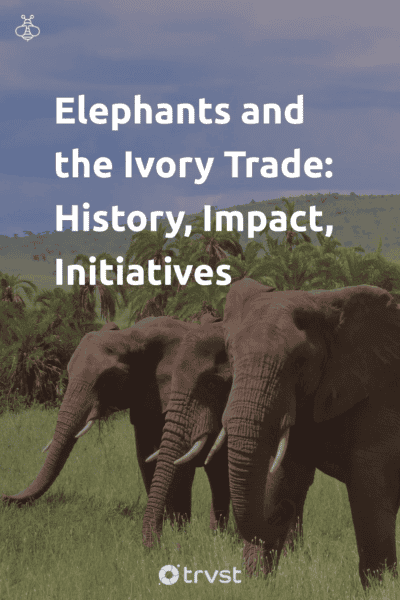Elephants and the Ivory Trade: History, Impact, Initiatives
Elephants are majestic creatures with incredible intelligence and memory. However, the elephants and the ivory trade, an issue running for centuries, is a serious topic we should highlight if we want future generations to still live with the largest terrestrial animals.
Humans use ivory to craft everything from tools to jewelry, figurines, and other ivory products. Over the years, the demand has increased, giving rise to the illegal ivory trade that has led to the decline of elephant populations globally.
Read on as we explore the devastating relationship between elephants and the ivory trade and the consequences.
Related Read: Elephant Facts.
When did the elephant ivory trade begin?
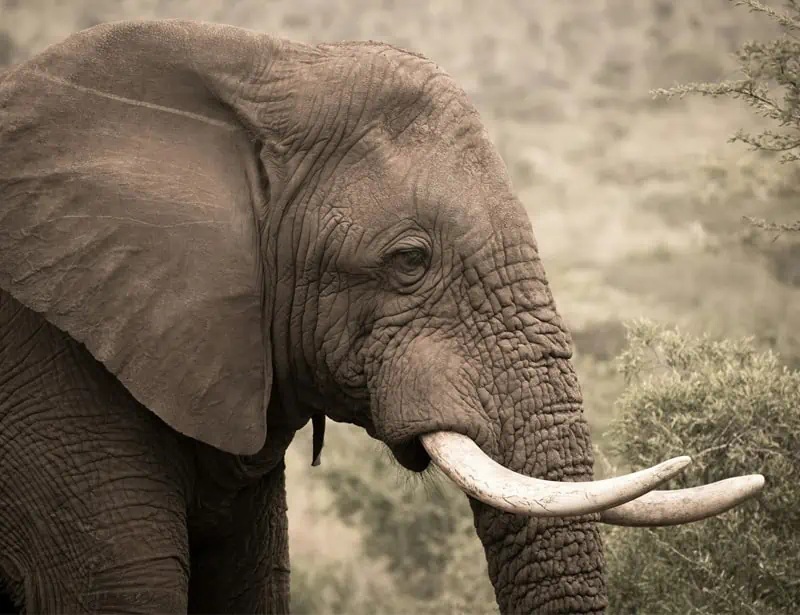
The use of elephant tusks for ivory dates back to ancient times. Ancient civilizations, including Greeks, Egyptians, Romans, and Chinese, valued ivory for its beauty and durability. They used elephant ivory to carve tools, sculptures, art, and religious artifacts.
Over the years, especially with the Industrial Revolution, there has been a surge in ivory demand, leading to the killing of elephants at an alarming rate and, ultimately, a decline in elephant populations.
During the colonial period, ivory was also interconnected with the slave trade, where European traders would exchange goods like firearms for raw tusks and then use elephant ivory to purchase enslaved people.
Today, we have several legal restrictions from various countries to reduce demand and regulate the ivory trade. However, despite these restrictions, we still see the high demand and supply for ivory in some markets, encouraging the killing of elephants and the illicit ivory trade.
The African Elephant Poaching Crisis
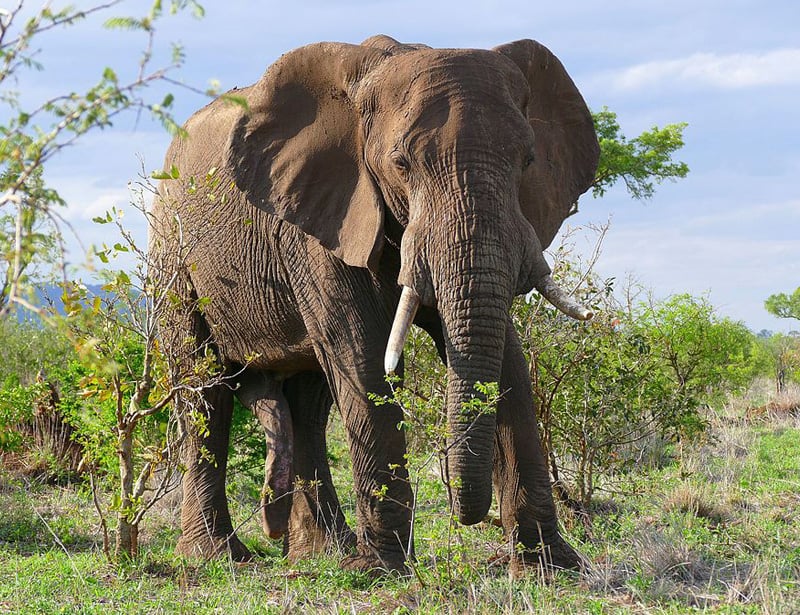
While both African elephants and Asian elephants have ivory, many prefer the African elephant ivory because it is larger and more durable. In addition, all African elephants have tusks, but only male Asian elephants have true elephant tusks, while female Asian elephants grow short tusks.
Due to the differences, the African elephant has a higher risk of elephant poaching. Bush poachers in African countries harvest the ivory tusks and move them by middlemen to seaports. They then ship these elephant ivory tusks to consumer countries like the Middle East, South Asia, and China for processing.
African elephants fall at risk of extinction due to this poaching crisis that funds illegal ivory trade. Savannah elephants in both East Africa and Southern Africa are at serious risk, and forest elephants in West and Central Africa are also declining.
As of 1979, the African elephant population was around 1.3 million. Sadly, by the mid-1990s, the population dropped massively5 below 300,000.
While some claimed that the problem was due to habitat loss, a deeper look revealed that the international ivory trade was the primary threat.
One of the biggest contributing factors to poaching is the demand for ivory. Other factors include poverty and corruption. In countries with scarce economic opportunities, people turn to the elephant ivory trade to generate income for themselves, their families, and local communities.
Sadly, African elephant poaching is still prevalent today as international criminals are still smuggling vast quantities of ivory for illicit profits.
According to the International Union for the Conservation of Nature (IUCN), elephants in Africa fall under two categories, both of which are near extinction. Savannah elephants are classified as endangered6, while forest elephants are critically endangered.
The Global Ivory Trade: Organized Crime and Terrorism
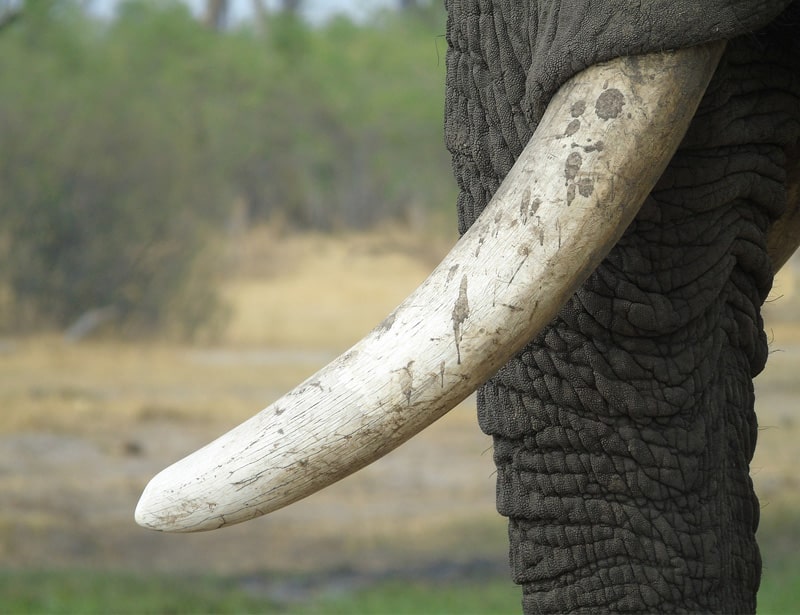
One of the major beneficiaries of the illegal trade in ivory is organized criminal syndicates and terrorist groups.
While poaching of endangered species (particularly elephants and other wildlife) has led to a conservation crisis, it has massive profits for terrorist organizations. Proceeds from this organized wildlife crime go into funding various activities within these terrorist groups.
According to credible reports, the illegal wildlife trade generates an estimated $19 billion a year, which is more than the illegal trafficking of natural resources like gold, diamond, and platinum, as well as small arms. It ranks number four of the most lucrative illegal activities behind drug trafficking and human trafficking4.
Sadly, the poaching of elephants is easy money for ivory traffickers.
Several reports show similar links between Wildlife crime and groups like the Lord Resistance Army, Al-Shabaab, and al-Qaeda. These terrorist groups also use profits from ivory sales for illegal arms trade.
Military groups and corrupt government officials are no exemption from this organized illegal ivory trafficking. Some military and paramilitary groups poach elephants from neighboring countries for the illegal trade of ivory.
Today, huge crime networks still engage in ivory trafficking, using legal ivory markets as a cover to launder illegal ivory.
Environmental Impact of The Ivory Trade
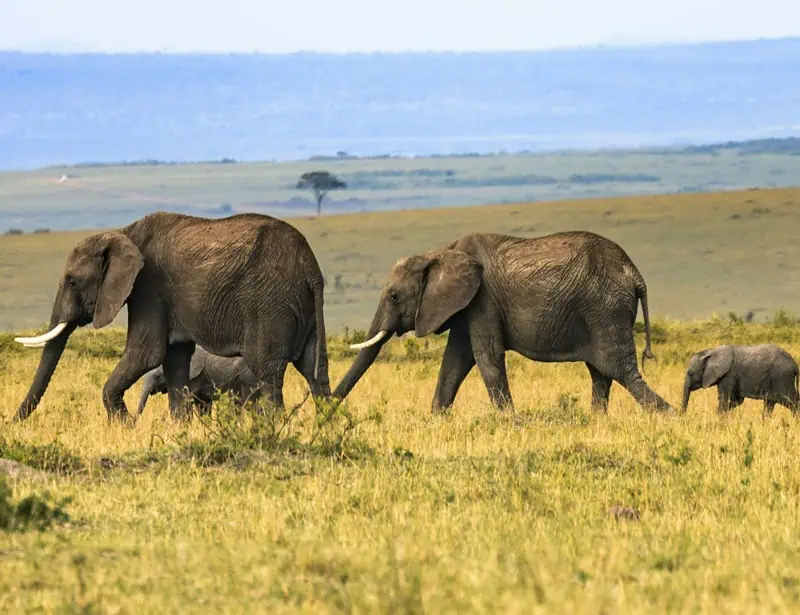
The elephant ivory trade not only reduces the elephant population but also has a significant environmental impact.
We know that elephants contribute significantly to the overall biodiversity of our planet. For one, elephants can change their environment by trampling vegetation that helps plants grow on the forest floor. These plants provide a food supply for herbivorous animals like antelopes, hogs, buffalos, and so on.
After elephants munch on vegetation, which includes seeds, they pass nutrients, organic matter, and seeds into the soil through their droppings, making them powerful seed and nutrient transporters.
The seeds of many plant species rely on elephants' gut to germinate.
The ivory trade, combined with factors like habitat loss, threatens the survival of these keystone species, which can affect other species and have an overall impact on maintaining healthy ecosystems.
Conserving Elephants: International Laws and Initiatives
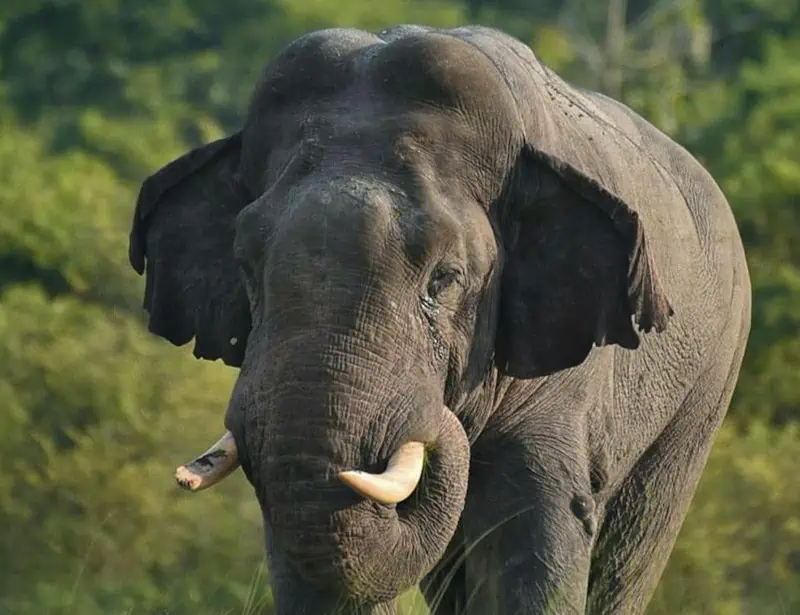
The elephant ivory trade is a global enterprise that travels through African countries to the rest of the world. International laws and initiatives are essential to reduce elephant poaching and conserve elephant populations.
Here are some laws and initiatives that regulate elephant ivory trade and protect elephants:
The Convention on International Trade in Endangered Species of Wild Fauna and Flora (CITES)
CITES, or the Convention on International Trade in Endangered Species of Wild Fauna and Flora, is an agreement among governments to regulate or ban the international trade of threatened or endangered species.
In the mid-20th century, governments worldwide saw the devastating impact of illegal wildlife trade and how it affected the species involved in the trade.
Some of these species were moving into extinction through the unsustainable use for food, medicine, and other purposes.
While some governments had the power to control the domestic ivory trade, it was practically impossible to control the international trade of these species.
Finally, in 1973, 21 countries signed the CITES agreement to address the issues. CITES offers three levels of regulation: Appendix I, Appendix II, and Appendix III, with Appendix I being the tightest level and Appendix III being the most lax.
By 1975, CITES listed Asian elephants under Appendix I, which meant a total trade ban on Asian elephant ivory. African elephants, on the other hand, fell under Appendix III. But this later changed to Appendix I except for elephants in Botswana, Namibia, South Africa, and Zimbabwe, which fall under the CITES Appendix II.
These countries lobbied for Appendix II, which comes with a warning prohibiting regular commercial ivory trade but allowing authorized ivory sales.
Some countries rejected the trade ban but later agreed due to international pressures. During this time, demand fell, making it challenging to sell ivory illegally and leaving many countries in Africa with stockpiled ivory.
Also, CITES uses two systems to track elephant poaching: Monitoring the Illegal Killing of Elephants (MIKE) and Elephant Trade Information System (ETIS), a centralized database that holds tens of thousands of records that provide critical information on illegal ivory trafficking.
The United States ban on the commercial trade of ivory in 2016
The United States is a major ivory market and is one of the largest consumers of illegally poached ivory. The U.S. Fish and Wildlife Service implemented a near-total ban on the trade of African elephant ivory on July 6, 2016. The law was created to curb the killing of elephants and prevent wildlife trafficking in the United States.
Formerly, people could sell ivory if the ivory came into the country before the elephants were listed as endangered or if a document proved that the elephant died naturally. However, the new law further restricts sales to only antiques like artwork, ivory statues, and musical instruments made with less than 200 grams1.
The near-total ban on elephant ivory in the United States was impactful. It spurred action in Asian countries like Singapore, Hong Kong, and, most significantly, mainland China.
China’s 2017 ivory ban
Only a few years ago, China was one of the biggest ivory markets. However, China made a major move to protect the elephant population by confirming the closure of its legal domestic ivory market in 2017.
In China today, it is illegal to set up any stall or market to trade ivory or ivory products. Selling ivory online and bringing ivory souvenirs from other countries back into China is also illegal. As a result of the ban, consumers’ desire to purchase ivory has continued to drop significantly over the years.
According to a study by the World Wildlife Fund (WWF), the number of “Diehard Buyers” dropped to 8% in 2020, almost half of the pre-ban level. However, while this is a major move for mainland China, other markets remain open and ready to serve Chinese nationals, especially Chinese tourists traveling abroad3.
The UK Ivory Act 2018
To protect the future of elephants, the UK government passed a law to close domestic markets in the United Kingdom. Under the Ivory Act 2018, neither the seller nor buyer can deal with ivory, making it one of the toughest bans in the world. People cannot buy, sell, hire, export, or import ivory into the UK.
However, the law provided some exemptions for ivory items that meet specific criteria. These criteria include pre-1918 elephant ivory items with artistic or cultural significance, pre-1975 musical instruments, items with low elephant ivory content, etc.
A group of antique dealers, the Friends of Antique Cultural Treasures Ltd (FACT), sued the government, challenging the legality of the Ivory Act. Lawyers representing the government argued that the legal ivory trade still increased the risk of illegal trade of ivory, ultimately affecting elephants in Africa and Asia.
The group of antique dealers, FACT, were allowed to appeal, and this was heard in the Supreme Court in 2020, of which the Supreme Court rejected the appeal2. It wasn't until June 6, 2022, that the Act finally came into full force.
Today, the Ivory Act 2018 extends to five more species as research shows demand for non-elephant ivory like hippo ivory and walrus ivory. Today, the Act prohibits trading in ivory from hippos, narwhals, killer whales, sperm whales, and walruses.
Elephant Ivory Trade Laws From Source Countries
Apart from international agreements like CITES, African nations that are home to elephants also have domestic laws that control poaching and ivory trafficking. Some of the laws attract jail time or fines. Here are some laws that govern the domestic ivory market in some African nations:
- The Wildlife Conservation and National Parks Act of 1992 in Botswana. A violation of this act attracts a ten-year prison sentence and 50,000 pula (about US $5,000).
- Under Namibian law, elephants fall under “Specially Protected Game” governed by the Nature Conservation Ordinance of 1975 (pdf). This law prohibits the illegal hunting of elephants and possessing elephant parts without a proper permit. Violation of this law could attract up to 20 years imprisonment.
- The Zambia Wildlife Act 2015 prohibits the illegal hunting of elephants. Violating this act could attract up to twenty years imprisonment with a five-year mandatory sentence for a first-time offense.
- The Parks and Wildlife Act of 1975 in Zimbabwe prohibits elephant poaching, and violating this act could attract a fine of $20,000. In addition, persons with the unlawful possession of ivory could face up to 20 years in prison.
Wrapping up: Elephants and the Ivory Trade
Over the years, we have seen significant changes in reducing the supply and demand for ivory. Legislation from different countries coupled with campaigns from environmental and NGO groups like the World Wildlife Fund (WWF) and the Environmental Investigation Agency (EIA) has helped to curb demand in countries that were formerly major ivory markets.
However, we still have progress to make. The ivory trade continues to threaten the survival of elephants as criminals adopt new methods for elephant poaching and illegal trade in ivory.
| 1 |
U.S. Department of the Interior. (2016). Administration takes bold step for African elephant conservation: Completes Near-Total Elephant Ivory Ban to cut off opportunities for traffickers. U.S. Department of The Interior. |
| 2 |
Environmental Investigation Agency UK. (2020). Supreme Court quashes the antiques trade’s final bid to kill off the UK Ivory Act! EIA. |
| 3 |
Meijer, W., Bergin, T., Cheng, D., Yang, C. and Kritski, E. (2020). Demand under the Ban – China Ivory Consumption Research 2020. WWF, Beijing, China. |
| 4 |
International Fund for Animal Welfare (IFAW). (2014). Wanted - Dead or Alive Exposing Online Wildlife Trade. https://www.ifaw.org/resources/wanted-dead-or-alive-report |
| 5 |
Ritchie, H. (2022). The state of the world’s elephant populations. Our World in Data. |
| 6 |
Gobush, K.S., Edwards, C.T.T, Balfour, D., Wittemyer, G., Maisels, F. & Taylor, R.D. (2022). Loxodonta africana (amended version of 2021 assessment). The IUCN Red List of Threatened Species 2022: e.T181008073A223031019. |
Jen’s a passionate environmentalist and sustainability expert. With a science degree from Babcock University Jen loves applying her research skills to craft editorial that connects with our global changemaker and readership audiences centered around topics including zero waste, sustainability, climate change, and biodiversity.
Elsewhere Jen’s interests include the role that future technology and data have in helping us solve some of the planet’s biggest challenges.
Fact Checked By:
Isabela Sedano, BEng.

